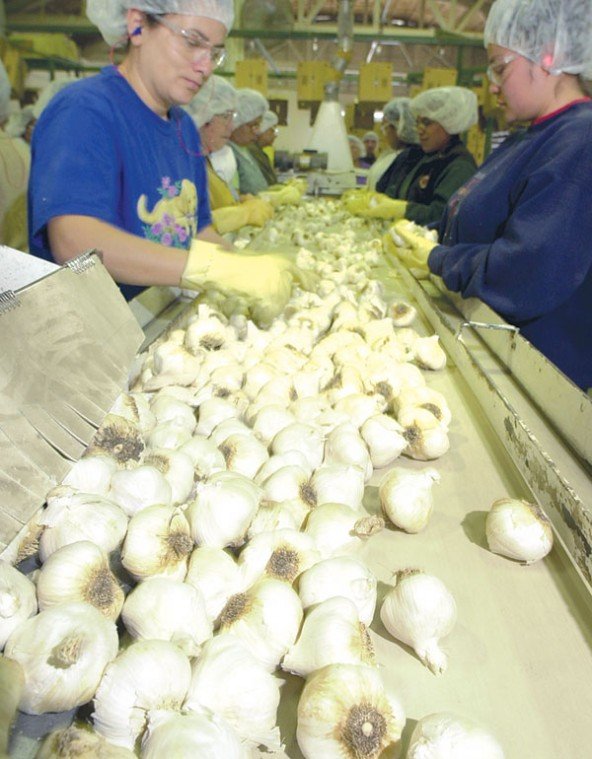GILROY
– Add the recent outbreak of SARS in China to the popular
Chinese belief in the medicinal power of garlic and the result is
expanding markets for Gilroy garlic growers – not in China, but at
home.
GILROY – Add the recent outbreak of SARS in China to the popular Chinese belief in the medicinal power of garlic and the result is expanding markets for Gilroy garlic growers – not in China, but at home.
“The Chinese are buying up all their garlic and none is left for export,” said Patsy Ross, the vice president of marketing for local fresh garlic producing Goliath Christopher Ranch. “China is our biggest competition, so this is a good thing for us.”
Ever since SARS (Severe Acute Respiratory Syndrome) began rapidly spreading throughout China in early April, Chinese medical experts have encouraged China’s 1.3 billion citizens to consume as much garlic as possible, citing the plant as a natural antibiotic.
And although China produces two-thirds of the world’s garlic – 13 billion pounds a year, 50 million of which is exported to the United States – Chinese government officials have recently ordered producers of the country’s stinking crop to halt all exports in favor of domestic demands until SARS is controlled, according to local importers.
The result is a wide-open market for Gilroy area garlic farmers and processors, who since the early 1990s have been battling China for domestic customers.
China provided Americans with a third of their garlic consumed in 2002, according the Fresh Garlic Producers Association.
“Garlic is normally very popular in northern China, but not in south China where the population is more dense,” said Emily Jin, the vice president of marketing for Eastsun Foods in Sunnyvale. Eastsun is a wholesale warehouse specializing in Chinese imported agricultural foods and spices; Chinese garlic normally makes up 90 percent of Eastsun’s sales.
“Now people in southern China are consuming large amounts of garlic, too, so for the first time supply is becoming a problem,” Jin said. “This is giving U.S. processors a great chance for a larger market share, but I don’t expect the shortage will last much longer.”
Ross said the 4,000-acre Christopher Ranch, the largest producer of fresh garlic in the United States at 70 million pounds a year, was fortunate to have 10 million extra pounds of fresh garlic in stock this year which it plans to sell to American garlic customers who normally rely on Chinese garlic.
Ross sees the temporary ban on garlic export as a way for local garlic producers to win back domestic customers who were lost in the early 1990s when Chinese garlic began to flood the United States and international markets.
In 2001, Americans consumed 150 million pounds of fresh garlic, according to the Fresh Garlic Producers Association. But China’s temporary halt on exports shouldn’t drive up retail garlic prices too much, Ross said, and plenty of garlic should be available for the 25th Annual Garlic Festival July 25 to 27.
“Most of the larger markets in the area are loyal to California garlic anyway,” she said. “And even the smaller markets that buy and sell the untariffed garlic rarely pass on the savings to the customer. … There is plenty of garlic in stock and in the ground right now.”
The fight against Chinese garlic began when exports of fresh garlic from China to the United States jumped from three million pounds a year in 1992 to 64 million pounds in 1994, according to the Fresh Garlic Growers Association.
China was selling its garlic for as much as 30 percent below United States growers because of its cheap labor cost. Chinese workers typically make $1 a day of picking garlic, while farms such as Christopher Ranch pay field workers $8 an hour to pick garlic.
That’s why in 1994 United States Customs placed a 376 percent import tariff on fresh garlic grown in China. The measure has significantly leveled the playing field for American garlic growers, although Chinese exporters and United States buyers have found ways around the tariff.
Today, Chinese garlic growers will often ship their garlic to countries such as Thailand, Vietnam, Spain and the Philippines, where the cargo tag is illegally altered before arriving in the United States and escaping the tariff, according both Ross and Jin. This practice is called “dumping.”
“For many people out there, they don’t care about the tariff, just getting the best price,” said Jin, who acknowledges that even with the 376 percent tariff Eastsun Foods pays for each shipment of garlic, her company often beats local garlic producers on prices. “Now these people have no other way except to pay full American garlic price.”















